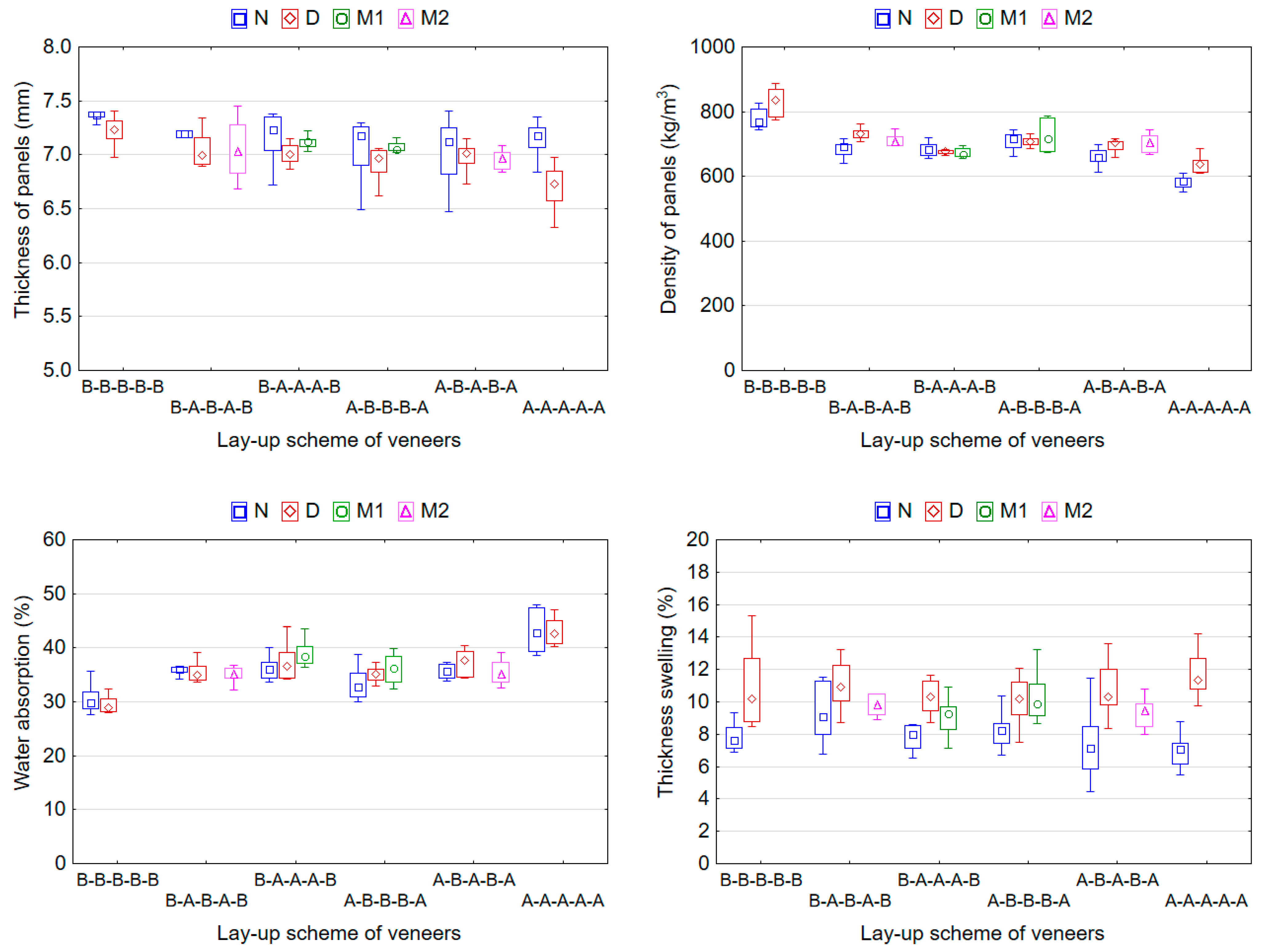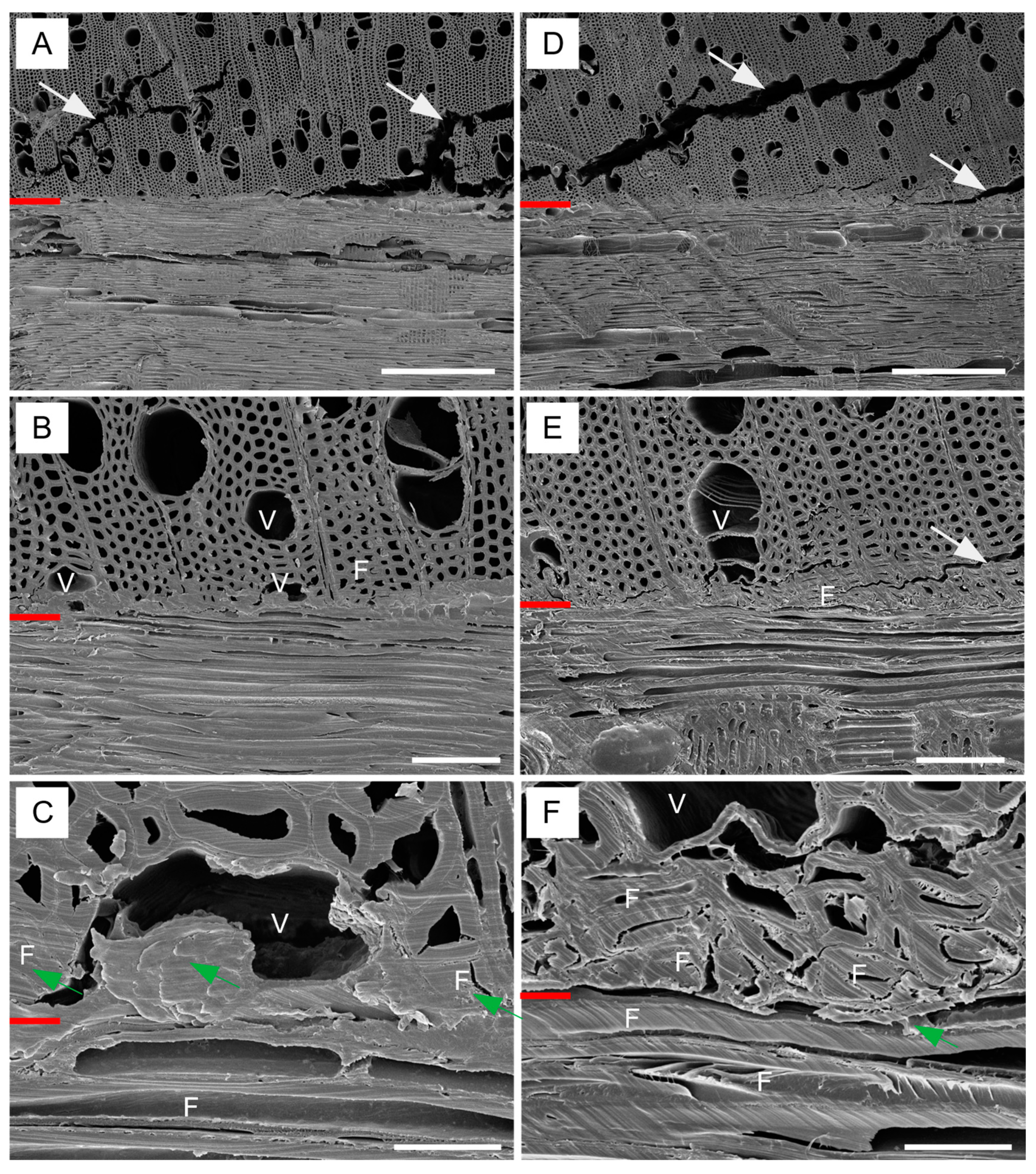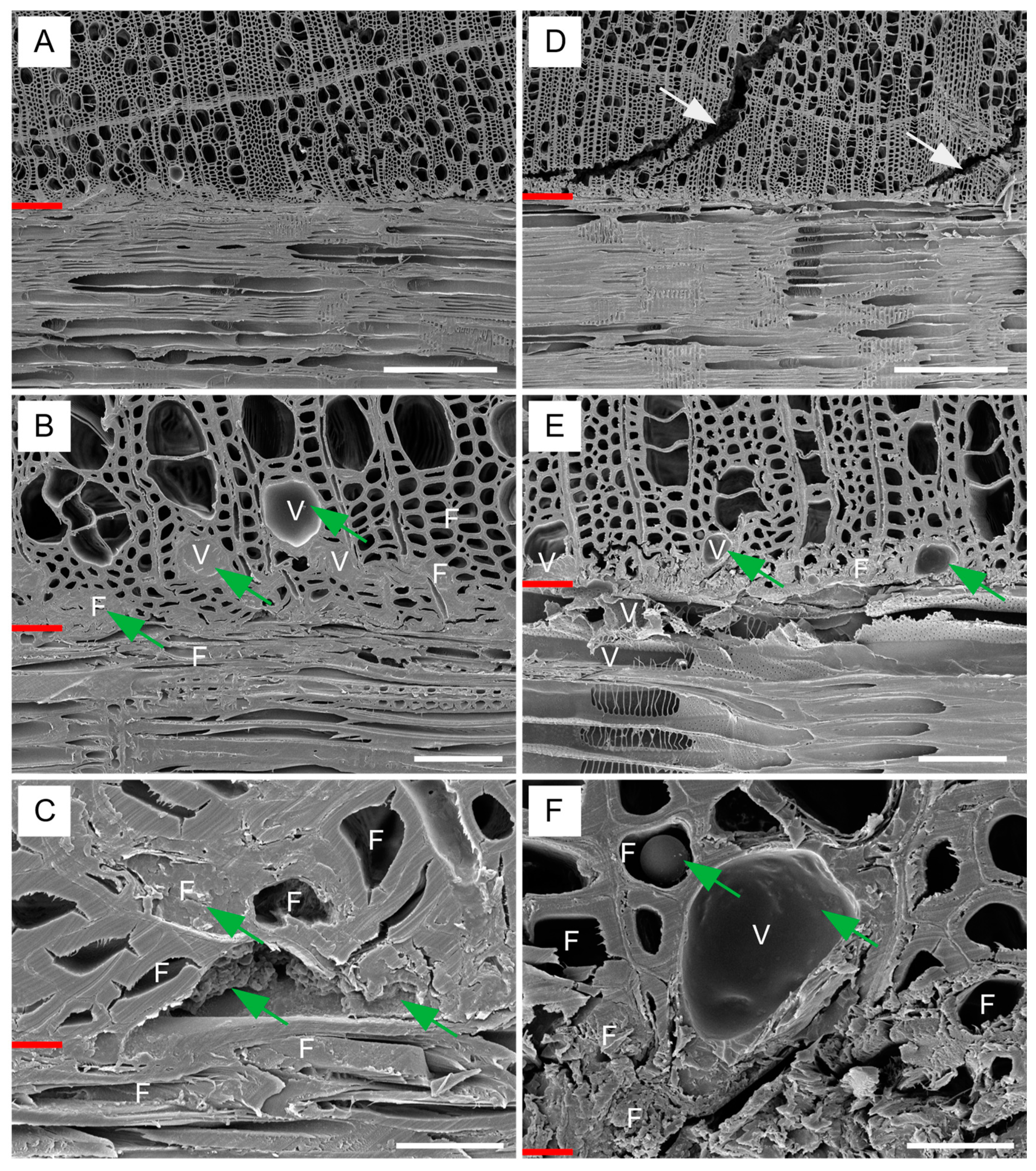Properties of Plywood Panels Composed of Thermally Densified and Non-Densified Alder and Birch Veneers
Abstract
1. Introduction
2. Materials and Methods
2.1. Materials
2.2. Thermal Compression of Veneer
2.3. Manufacturing and Testing of Plywood Samples
2.4. Statistical Analysis
3. Results and Discussion
3.1. Compression and Densification Ratio of Veneers
3.2. Thickness and Density of Plywood Samples
3.3. Mechanical Properties of Plywood Samples
4. Conclusions
Author Contributions
Funding
Acknowledgments
Conflicts of Interest
References
- Baldwin, R.F. Plywood and Veneer-Based Products: Manufacturing Practices; Miller Freeman: San Francisco, CA, USA, 1995; 388p. [Google Scholar]
- Aydin, I.; Colak, S.; Colakoglu, G.; Salih, E. A comparative study on some physical and mechanical properties of Laminated Veneer Lumber (LVL) produced from Beech (Fagus orientalis Lipsky) and Eucalyptus (Eucalyptus camaldulensis Dehn.) veneers. Eur. J. Wood Prod. 2004, 62, 218–220. [Google Scholar] [CrossRef]
- Ido, H.; Nagao, H.; Kato, H.; Miyatake, A.; Hiramatsu, Y. Strength properties of laminated veneer lumber in compression perpendicular to its grain. J. Wood Sci. 2010, 56, 422–428. [Google Scholar] [CrossRef]
- Ozarska, B. A review of the utilization of hardwoods for LVL. Wood Sci. Technol. 1999, 33, 341–351. [Google Scholar] [CrossRef]
- Navi, P.; Sandberg, D. Thermo-Hydro-Mechanical Wood Processing; EPFL Press: Lausanne, Switzerland; CRC Press, Taylor & Francis Group, LLC.: Boca Raton, FL, USA, 2012; 360p. [Google Scholar]
- Candan, Z.; Hiziroglu, S.; Mcdonald, A.G. Surface quality of thermally compressed Douglas fir veneer. Mater. Des. 2010, 31, 3574–3577. [Google Scholar] [CrossRef]
- Buyuksari, U. Surface characteristics and hardness of MDF panels laminated with thermally compressed veneer. Compos. B Eng. 2013, 44, 675–678. [Google Scholar] [CrossRef]
- Bekhta, P.; Proszyk, S.; Krystofiak, T. Colour in short-term thermo-mechanically densified veneer of various wood species. Eur. J. Wood Prod. 2014, 72, 785–797. [Google Scholar] [CrossRef]
- Bekhta, P.; Proszyk, S.; Lis, B.; Krystofiak, T. Gloss of thermally densified alder (Alnus glutinosa Goertn.), beech (Fagus sylvatica L.), birch (Betula verrucosa Ehrh.), and pine (Pinus sylvestris L.) wood veneers. Eur. J. Wood Prod. 2014, 72, 799–808. [Google Scholar] [CrossRef]
- Bekhta, P.; Proszyk, S.; Krystofiak, T.; Mamonova, M.; Pinkowski, G.; Lis, B. Effect of thermomechanical densification on surface roughness of wood veneers. Wood Mater. Sci. Eng. 2014, 9, 233–245. [Google Scholar] [CrossRef]
- Pelit, H.; Sönmez, A.; Budakçi, M. Effects of thermomechanical densification and heat treatment on density and Brinell hardness of Scots pine (Pinus sylvestris L.) and Eastern beech (Fagus orientalis L.). BioResources 2015, 10, 3097–3111. [Google Scholar] [CrossRef]
- Bekhta, P.; Sedliačik, J.; Jones, D. Effect of short-term thermomechanical densification of wood veneers on the properties of birch plywood. Eur. J. Wood Prod. 2018, 76, 549–562. [Google Scholar] [CrossRef]
- Bekhta, P.; Krystofiak, T.; Proszyk, S.; Lis, B. Adhesion strength of thermally compressed and varnished wood (TCW) substrate. Prog. Org. Coat. 2018, 125, 331–338. [Google Scholar] [CrossRef]
- Nzokou, P.; Zyskowski, J.; Boury, S.; Kamdem, D.P. Natural decay resistance of LVL made of veneers from durable and non-durable wood species. Holz Roh Werkst. 2005, 63, 173–178. [Google Scholar] [CrossRef]
- Burdurlu, E.; Kilic, M.; Ilce, A.C.; Uzunkavak, O. The effects of ply organization and loading direction on bending strength and modulus of elasticity in laminated veneer lumber (LVL) obtained from beech (Fagus orientalis L.) and lombardy poplar (Populus nigra L.). Constr. Build. Mater. 2007, 21, 1720–1725. [Google Scholar] [CrossRef]
- Nazerian, M.; Ghalehno, M.D.; Kashkooli, A.B. Effect of wood species, amount of juvenile wood and heat treatment on mechanical and physical properties of laminated veneer lumber. J. Appl. Sci. 2011, 11, 980–987. [Google Scholar] [CrossRef]
- Xue, B.; Hu, Y. Mechanical Properties Analysis and reliability Assessment of Laminated Veneer Lumber (LVL) Having Different Patterns of Assembly. BioResources 2012, 7, 1617–1632. [Google Scholar] [CrossRef][Green Version]
- Zdravković, V.; Lovrić, A.; Stanković, B. Dimensional Stability of Plywood Panels Made from Thermally Modified Poplar Veneers in the Conditions of Variable Air Humidity. Drv. Ind. 2013, 64, 175–181. [Google Scholar] [CrossRef]
- Bal, B.C. Some technological properties of laminated veneer lumber produced with fast-growing poplar and eucalyptus. Maderas Cienc. Y Tecnol. 2016, 18, 24–39. [Google Scholar] [CrossRef]
- Lovrić, A.; Zdravković, V.; Popadić, R.; Milić, G. Properties of Plywood Boards Composed of Thermally Modified and Non-modified Poplar Veneer. BioResources 2017, 12, 8581–8594. [Google Scholar]
- Ilce, A. Mechanical properties of laminated veneer lumber made from ash and red pine woods. BioResources 2018, 13, 8653–8661. [Google Scholar] [CrossRef]
- McGavin, R.L.; Nguyen, H.H.; Gilbert, B.P.; Dakin, T.; Faircloth, A. A comparative Study on the Mechanical Properties of Laminated Veneer Lumber (LVL) Produced from Blending Various Wood Veneers. BioResources 2019, 14, 9064–9081. [Google Scholar]
- Kallakas, H.; Rohumaa, A.; Vahermets, H.; Kers, J. Effect of Different Hardwood Species and Lay-Up Schemes on the Mechanical Properties of Plywood. Forests 2020, 11, 649. [Google Scholar] [CrossRef]
- Hsu, F.Y.; Hung, K.C.; Xu, J.W.; Wu, T.L.; Wu, J.H. Physicomechanical properties and creep behavior of plywood composed of fully and partially heat-treated veneers. Wood Sci. Technol. 2021, 55, 445–460. [Google Scholar] [CrossRef]
- H’ng, P.S.; Paridah, M.; Chin, K. Bending properties of laminated veneer lumber produced from Keruing (Dipterocarpus sp.) reinforced with low density wood species. Asian J. Sci. Res. 2010, 3, 118–125. [Google Scholar] [CrossRef]
- Kilic, Y.; Burdurlu, E.; Elibol, G.C.; Ulupinar, M. Effect of layer arrangement on expansion, bending strength and modulus of elasticity of solid wood and laminated veneer lumber (LVL) produced from pine and poplar. Gazi Univ. J. Sci. 2010, 23, 89–96. [Google Scholar]
- Bekhta, P.; Salca, E.A.; Lunguleasa, A. Some properties of plywood panels manufactured from combinations of thermally densified and non-densified veneers of different thickness in one structure. J. Build. Eng. 2020, 29, 101116. [Google Scholar] [CrossRef]
- EN 322; Wood-Based Panels—Determination of Moisture Content. European Committee for Standardization: Brussels, Belgium, 1993.
- EN 323; Wood-Based Panels—Determination of Density. European Committee for Standardization: Brussels, Belgium, 1993.
- EN 310; Wood-Based Panels—Determination of Modulus of Elasticity in Bending and of Bending Strength. European Committee for Standardization: Brussels, Belgium, 1993.
- EN 314-1; Plywood—Bonding Quality—Part 1: Test Methods. European Committee for Standardization: Brussels, Belgium, 2004.
- EN 314-2; Plywood—Bonding Quality—Part 2: Requirements. European Committee for Standardization: Brussels, Belgium, 1993.
- EN 317; Particleboards and Fibreboards: Determination of Swelling in Thickness after Immersion in Water. European Committee for Standardization: Brussels, Belgium, 1993.
- Arruda, L.; Del Menezzi, C.H.S. Effect of thermomechanical treatment on physical properties of wood veneers. Int. Wood Prod. J. 2013, 4, 217–224. [Google Scholar] [CrossRef]
- Bekhta, P.; Proszyk, S.; Krystofiak, T.; Sedliačik, J.; Novák, I.; Mamonova, M. Effect of short-term thermomechanical densification on the structure and properties of wood veneers. Wood Mater. Sci. Eng. 2017, 12, 40–54. [Google Scholar] [CrossRef]
- Rautkari, L.; Hughes, M.; Properzi, M.; Pichelin, F. Properties and chemical changes of surface densified wood. In Proceedings of the 11th World Conference on Timber Engineering, Trentino, Italy, 20–24 June 2010; Trees and Timber Institute, National Research Council: Trentino, Italy, 2010; pp. 235–237. [Google Scholar]
- EN 315; Plywood. Tolerances for Dimensions. European Committee for Standardization: Brussels, Belgium, 2000.
- Sheldon, S.; Walker, J. Wood-based composites: Plywood and veneer-based products. In Primary Wood Processing: Principles and Practice, 2nd ed.; Walker, J., Ed.; Springer: New York, NY, USA, 2006; pp. 391–426. [Google Scholar]
- Salca, E.-A.; Bekhta, P.; Seblii, Y. The effect of veneer densification temperature and wood species on the plywood properties made from alternate layers of densified and non-densified veneers. Forests 2020, 11, 700. [Google Scholar] [CrossRef]
- Marra, A.A. Technology of Wood Bonding: Principles in Practice; Van Nostrand Reinhold: New York, NY, USA, 1992; 453p. [Google Scholar]
- Wagenführ, R. Holzatlas; Fachbuchverlag Leipzig im Carl Hanser: München, Germany, 2000; 707p. [Google Scholar]







| Code of Panels | Type of Panels | Veneer Assembly Pattern by Wood Species | Veneer Assembly Pattern by Type of Veneer Treatment |
|---|---|---|---|
| I | BN–BN–BN–BN–BN | B–B–B–B–B | N–N–N–N–N |
| II | BN–AN–BN–AN–BN | B–A–B–A–B | N–N–N–N–N |
| III | BN–AN–AN–AN–BN | B–A–A–A–B | N–N–N–N–N |
| IV | AN–BN–BN–BN–AN | A–B–B–B–A | N–N–N–N–N |
| V | AN–BN–AN–BN–AN | A–B–A–B–A | N–N–N–N–N |
| VI | AN–AN–AN–AN–AN | A–A–A–A–A | N–N–N–N–N |
| VII | BD–AN–AN–AN–BD | B–A–A–A–B | D–N–N–N–D |
| VIII | AD–BN–BN–BN–AD | A–B–B–B–A | D–N–N–N–D |
| IX | BD–AN–BD–AN–BD | B–A–B–A–B | D–N–D–N–D |
| X | AD–BN–AD–BN–AD | A–B–A–B–A | D–N–D–N–D |
| XI | BD–BD–BD–BD–BD | B–B–B–B–B | D–D–D–D–D |
| XII | BD–AD–BD–AD–BD | B–A–B–A–B | D–D–D–D–D |
| XIII | BD–AD–AD–AD–BD | B–A–A–A–B | D–D–D–D–D |
| XIV | AD–BD–BD–BD–AD | A–B–B–B–A | D–D–D–D–D |
| XV | AD–BD–AD–BD–AD | A–B–A–B–A | D–D–D–D–D |
| XVI | AD–AD–AD–AD–AD | A–A–A–A–A | D–D–D–D–D |
| Wood Species | Density of Veneer (kg/m3) | Compression Ratio (%) | Densification Ratio (%) | |
|---|---|---|---|---|
| Non-Densified | Densified | |||
| Alder | 487 (21) | 528 (20) | 11.5 (2.3) | 8.3 (1.9) |
| Birch | 677 (41) | 708 (51) | 8.2 (1.4) | 4.6 (0.8) |
| Code of Panel | Type of Panel | Thickness (mm) | Density (kg/m3) | WA (%) | TS (%) |
|---|---|---|---|---|---|
| I | BN–BN–BN–BN–BN | 7.4 g (0.1) | 779 h (31) | 30.4 a (2.4) | 7.9 abc (0.9) |
| II | BN–AN–BN–AN–BN | 7.2 def (0.2) | 685 cde (24) | 36.3 c (2.0) | 9.4 cdef (1.7) |
| III | BN–AN–AN–AN–BN | 7.2 ef (0.2) | 684 cde (20) | 36.3 c (2.2) | 8.0 abc (1.3) |
| IV | AN–BN–BN–BN–AN | 7.0 bcdef (0.3) | 709 ef (27) | 33.2 b (2.7) | 8.5 abcd (1.4) |
| V | AN–BN–AN–BN–AN | 7.0 bcdef (0.3) | 661 bc (27) | 35.6 bc (1.3) | 7.6 ab (2.2) |
| VI | AN–AN–AN–AN–AN | 7.2 cdef (0.1) | 583 a (18) | 43.0 e (3.9) | 7.2 a (1.3) |
| VII | BD–AN–AN–AN–BD | 7.1 cdef (0.1) | 673 cd (15) | 39.0 d (2.5) | 9.0 bcde (1.1) |
| VIII | AD–BN–BN–BN–AD | 7.1 bcdef (0.1) | 726 fg (52) | 36.2 c (2.8) | 10.3 ef (1.4) |
| IX | BD–AN–BD–AN–BD | 7.1 bcdef (0.3) | 712 ef (18) | 35.0 bc (1.4) | 10.0 def (1.9) |
| X | AD–BN–AD–BN–AD | 7.0 bc (0.1) | 703 ef (29) | 35.3 bc (2.2) | 9.3 cdef (1.0) |
| XI | BD–BD–BD–BD–BD | 7.2 fg (0.2) | 832 i (44) | 29.3 a (1.4) | 10.9 fg (2.3) |
| XII | BD–AD–BD–AD–BD | 7.0 bcd (0.3) | 744 g (47) | 35.5 bc (1.9) | 10.9 fg (1.5) |
| XIII | BD–AD–AD–AD–BD | 7.0 bcde (0.1) | 675 cd (6) | 37.3 cd (3.3) | 10.3 ef (1.0) |
| XIV | AD–BD–BD–BD–AD | 6.9 b (0.1) | 708 ef (14) | 34.6 bc (2.2) | 10.1 ef (1.5) |
| XV | AD–BD–AD–BD–AD | 7.0 bcd (0.1) | 695 de (18) | 37.3 cd (2.5) | 10.9 fg (2.1) |
| XVI | AD–AD–AD–AD–AD | 6.7 a (0.2) | 638 b (24) | 41.9 e (4.6) | 12.1 g (1.9) |
| Source of Variation | Thickness | Density | WA | TS | ||||
|---|---|---|---|---|---|---|---|---|
| F | Sig. | F | Sig. | F | Sig. | F | Sig. | |
| W | 9.464 | 0.000 | 101.404 | 0.000 | 51.493 | 0.000 | 1.527 | 0.185 |
| T | 10.355 | 0.000 | 13.334 | 0.000 | 4.148 | 0.007 | 31.045 | 0.000 |
| W × T | 1.837 | 0.084 | 4.625 | 0.000 | 0.966 | 0.458 | 2.526 | 0.018 |
| Code of Panels | Type of Panels | MOR (MPa) | MOE (MPa) | Shear Strength (MPa) |
|---|---|---|---|---|
| I | BN–BN–BN–BN–BN | 110 d (10) | 12405 f (405) | 2.8 bc (0.6) |
| II | BN–AN–BN–AN–BN | 97c (17) | 9765 cd (1644) | 3.2 cde (0.5) |
| III | BN–AN–AN–AN–BN | 101 cd (10) | 11,033 e (996) | 2.9 cd (0.6) |
| IV | AN–BN–BN–BN–AN | 75 a (8) | 7934 a (1363) | 3.7 fg (0.5) |
| V | AN–BN–AN–BN–AN | 88 b (14) | 9392 bc (1583) | 3.0 cde (0.8) |
| VI | AN–AN–AN–AN–AN | 75 a (5) | 8103 a (648) | 2.9 cd (0.6) |
| VII | BD–AN–AN–AN–BD | 99 c (8) | 10,893 e (798) | 3.4 ef (0.6) |
| VIII | AD–BN–BN–BN–AD | 73 a (6) | 8644 ab (1221) | 3.7 fg (0.6) |
| IX | BD–AN–BD–AN–BD | 105 cd (8) | 10,970 e (785) | 3.3 def (0.8) |
| X | AD–BN–AD–BN–AD | 79 a (7) | 8796 abc (1170) | 3.8 g (0.7) |
| XI | BD–BD–BD–BD–BD | 119 e (14) | 12,290 f (1409) | 3.2 cde (0.6) |
| XII | BD–AD–BD–AD–BD | 102 cd (11) | 10,758 de (557) | 2.2 a (0.2) |
| XIII | BD–AD–AD–AD–BD | 101 cd (5) | 10,670 de (995) | 3.2 cde (0.3) |
| XIV | AD–BD–BD–BD–AD | 79 a (5) | 8913 abc (717) | 3.2 cde (0.6) |
| XV | AD–BD–AD–BD–AD | 80 ab (7) | 9361 bc (691) | 3.7 fg (0.5) |
| XVI | AD–AD–AD–AD–AD | 78 a (9) | 8345 ab (1111) | 2.5 ab (0.5) |
| Source of Variation | MOR | MOE | Shear Strength | |||
|---|---|---|---|---|---|---|
| F | Sig. | F | Sig. | F | Sig. | |
| W | 62.765 | 0.000 | 48.591 | 0.000 | 12.048 | 0.000 |
| T | 0.998 | 0.396 | 0.782 | 0.506 | 9.562 | 0.000 |
| W × T | 1.881 | 0.077 | 1.825 | 0.086 | 7.326 | 0.000 |
Disclaimer/Publisher’s Note: The statements, opinions and data contained in all publications are solely those of the individual author(s) and contributor(s) and not of MDPI and/or the editor(s). MDPI and/or the editor(s) disclaim responsibility for any injury to people or property resulting from any ideas, methods, instructions or products referred to in the content. |
© 2023 by the authors. Licensee MDPI, Basel, Switzerland. This article is an open access article distributed under the terms and conditions of the Creative Commons Attribution (CC BY) license (https://creativecommons.org/licenses/by/4.0/).
Share and Cite
Bekhta, P.; Pipíška, T.; Gryc, V.; Sedliačik, J.; Král, P.; Ráheľ, J.; Vaněrek, J. Properties of Plywood Panels Composed of Thermally Densified and Non-Densified Alder and Birch Veneers. Forests 2023, 14, 96. https://doi.org/10.3390/f14010096
Bekhta P, Pipíška T, Gryc V, Sedliačik J, Král P, Ráheľ J, Vaněrek J. Properties of Plywood Panels Composed of Thermally Densified and Non-Densified Alder and Birch Veneers. Forests. 2023; 14(1):96. https://doi.org/10.3390/f14010096
Chicago/Turabian StyleBekhta, Pavlo, Tomáš Pipíška, Vladimír Gryc, Ján Sedliačik, Pavel Král, Jozef Ráheľ, and Jan Vaněrek. 2023. "Properties of Plywood Panels Composed of Thermally Densified and Non-Densified Alder and Birch Veneers" Forests 14, no. 1: 96. https://doi.org/10.3390/f14010096
APA StyleBekhta, P., Pipíška, T., Gryc, V., Sedliačik, J., Král, P., Ráheľ, J., & Vaněrek, J. (2023). Properties of Plywood Panels Composed of Thermally Densified and Non-Densified Alder and Birch Veneers. Forests, 14(1), 96. https://doi.org/10.3390/f14010096








